Would you ever say that the Upper Town, the medieval heart of the city, hides some beautiful art nouveau spots? Some very interesting news were introduced during the Belle Epoque, like the two Funiculars! This itinerary allows you to admire the old city centre from a different point of view, by going out of the Walls and strolling along the quiet streets leading to the Hills Park – Parco dei Colli. Here you will appreciate a perfect harmony among dwellings, palaces, nature and green oasis. The perfect environment for the refined “Liberty” (the Italian Art Nouveau trend) facades, featuring beautiful frescoes and sculptures imitating the shapes of nature.
The Upper Town – Città Alta – isn't just the home of beautiful monuments and palaces, but also a dynamic place adapting itself to the needs of its inhabitants. Here, between XIX and XX Century, the Viale delle Mura boulevard was opened, the two Funiculars were designed, many public spaces like the washhouses were built, along the residential districts all over the hills. Not to mention the attention paid to the ancient monuments: the Baptistery in Piazza Duomo was renovated and the Colleoni Chapel was protected with the current iron fence, created by Virginio Muzio, the same author of some of the most amazing Liberty buildings in Bergamo (Casa Paleni, Ristorante Belvedere and Villa Muzio).
On the other side, a new residential area was created on the hills and in 1912 the second funicular was inaugurated, enabling to reach San Vigilio Hill, the highest point in Bergamo. Walking along via Sudorno and via Torni you can admire some examples of Italian Art Nouveau where architecture actually “talks” with the surrounding nature. Patterns inspired by flowers and leaves, refined frescoes perfectly set in a serene atmosphere, perfectly preserved thanks to the institution of Parco dei Colli in 1977, which managed to regulate the building permits in the area.
Besides the Liberty, the thousand sides of Bergamo. Magnificent palaces, churches and monuments of different eras and styles come together as you walk along this itinerary. Read more on: “Le Vie della Storia - The History Routes” and “Le Vie del Verde – the Green Routes”.
Would you ever say that the Upper Town, the medieval heart of the city, hides some beautiful art nouveau spots? Some very interesting news were introduced during the Belle Epoque, like the two Funiculars! This itinerary allows you to admire the old city centre from a different point of view, by going out of the Walls and strolling along the quiet streets leading to the Hills Park – Parco dei Colli. Here you will appreciate a perfect harmony among dwellings, palaces, nature and green oasis. The perfect environment for the refined “Liberty” (the Italian Art Nouveau trend) facades, featuring beautiful frescoes and sculptures imitating the shapes of nature.
The Upper Town – Città Alta – isn't just the home of beautiful monuments and palaces, but also a dynamic place adapting itself to the needs of its inhabitants. Here, between XIX and XX Century, the Viale delle Mura boulevard was opened, the two Funiculars were designed, many public spaces like the washhouses were built, along the residential districts all over the hills. Not to mention the attention paid to the ancient monuments: the Baptistery in Piazza Duomo was renovated and the Colleoni Chapel was protected with the current iron fence, created by Virginio Muzio, the same author of some of the most amazing Liberty buildings in Bergamo (Casa Paleni, Ristorante Belvedere and Villa Muzio).
On the other side, a new residential area was created on the hills and in 1912 the second funicular was inaugurated, enabling to reach San Vigilio Hill, the highest point in Bergamo. Walking along via Sudorno and via Torni you can admire some examples of Italian Art Nouveau where architecture actually “talks” with the surrounding nature. Patterns inspired by flowers and leaves, refined frescoes perfectly set in a serene atmosphere, perfectly preserved thanks to the institution of Parco dei Colli in 1977, which managed to regulate the building permits in the area.
Besides the Liberty, the thousand sides of Bergamo. Magnificent palaces, churches and monuments of different eras and styles come together as you walk along this itinerary. Read more on: “Le Vie della Storia - The History Routes” and “Le Vie del Verde – the Green Routes”.
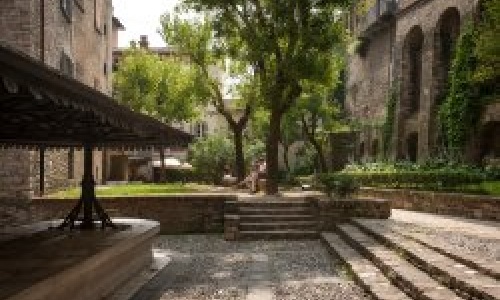
When you get to Città Alta, the Upper Town, with the Funicular, take a moment to abserve the upper Station, where Middle Age meets modernity. The zone where the coaches leave and arrive used to the the courtyard of Guidino Suardi's palace (you can still see his portrait on the external facade). The modern appearance of the interiors features medieval elements, such as the refined glass walls closing the acute arches of the ancient courtyard and creating the Café's entry door. As you go out the station, you can walk across a passage alternative to the most popular via Gombito, passing through Piazzetta Angelini and getting to the Washhouse in via Mario Lupo (1891). You can spot some Art Nouveau decorations on the columns of its roof, made of metal and plates. The square is a lovely green spot taking its name from the engineer Luigi Angelini, who designed its enlargement and opened the above-mentioned passage as part of a significant urban re-planning ( the Upper Town Renovation Plan approved by the Superior council for Public works in 1935). You can have a break here and admire the medieval tower called “del Gombito”, 52 meters high.
When you get to Città Alta, the Upper Town, with the Funicular, take a moment to abserve the upper Station, where Middle Age meets modernity. The zone where the coaches leave and arrive used to the the courtyard of Guidino Suardi's palace (you can still see his portrait on the external facade). The modern appearance of the interiors features medieval elements, such as the refined glass walls closing the acute arches of the ancient courtyard and creating the Café's entry door. As you go out the station, you can walk across a passage alternative to the most popular via Gombito, passing through Piazzetta Angelini and getting to the Washhouse in via Mario Lupo (1891). You can spot some Art Nouveau decorations on the columns of its roof, made of metal and plates. The square is a lovely green spot taking its name from the engineer Luigi Angelini, who designed its enlargement and opened the above-mentioned passage as part of a significant urban re-planning ( the Upper Town Renovation Plan approved by the Superior council for Public works in 1935). You can have a break here and admire the medieval tower called “del Gombito”, 52 meters high.
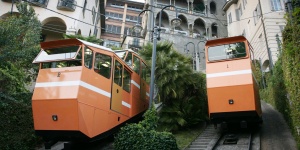
The Lower Funicular has been connecting the centre of Bergamo with the Upper Town (“Città Alta”) for more than 120 years, more precisely with Piazza Mercato delle Scarpe, where many business activities used to be carried out. The square (whose name means “shoes market square”) was used as a shoes market since 1430, while the building overlooking the square used to be the headquarter of the shoemakers’ guild and it currently hosts the funicular station.
The city’s funicular is really loved by Bergamo’s citizens, that couldn’t do without it: is there another means of transport allowing you to travel across time, passing through the ancient Venetian walls that used to defend Bergamo from the enemies’ attacks?
Two lovely orange coaches go up and down the hill, surrounded by beautiful gardens and amazing landscapes: when the sky is cloudless you can enjoy a breath-taking view on the Po plain and even catch sight of the Apennines!
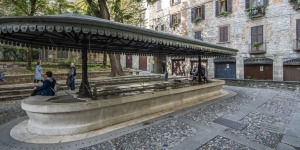
A long tank of white marble divided into different parts, covered by an elegant roof made of cast iron and metal slabs.
Built in 1881, the Washhouse (“Lavatoio” in Italian) via San Lupo, in the Upper Town, represents a beautiful model from the design point of view.
It’s provided with a water adduction system, an overflow drain system, a process of dirty water discharge after washing and a gutter of the water sprays produced during the washing: this makes it extremely effective and functional.
On the other side, the hygienic conditions of Bergamo during that time were really poor: in 1884 a cholera epidemic had pummelled the city and physicians blamed the water’s terrible quality of Città Alta, enhancing the spreading of typhus fever, a highly contagious and frequently deadly disease that recurred every summer.
To combat this problem, Bergamo Administration decided to build several public washhouses: besides the one in via Lupo, there was one in via Boccola and another in Borgo Canale.
The via Lupo Washhouse worked till the 50s and it’s currently preserved with the maximum care, as a precious memory of the past.
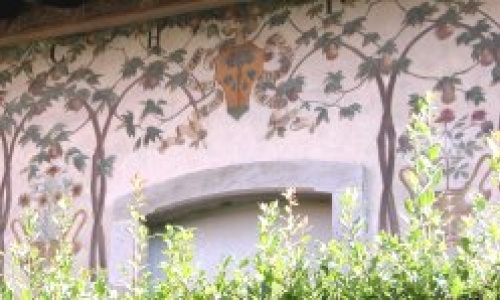
In Colle Aperto square, next to Sant'Alessandro Gate, you will notice a fascinating villa surrounded by high trees, whose main characteristic is the fresco portraying a young women. It was the home of the architect Virginio Muzio. As you overstep Sant'Alessandro Gate, a pleasant route across the trees will reveal more Liberty must-see. Along via San Vigilio, many wonderful villas were built in the early XX Century, along with the Funicular, which came into operation in 1912. On the other side, if you take via Sudorno – on your right – you will find the 1910 Nursery School at number 1B, decorated with beautiful frescoes: among the twisted branches painted all over the facade, there are also some alphabet letters, coats of arms and portraits of renowned figures from Bergamo. For instance, you can see the symbol of the Colleoni and the Tasso Families, along with the portrait of Gaetano Donizetti, the great music composer who was born just a few steps from here. Passing by this building, on the left, there is a splendid villa (in via Sudorno 6, approximately 1920), featuring an exquisite Liberty style in the facade's frames, in the pillars and in the entry gate. As you go on with your walk, you can also admire the beautiful surrounding hills.
In Colle Aperto square, next to Sant'Alessandro Gate, you will notice a fascinating villa surrounded by high trees, whose main characteristic is the fresco portraying a young women. It was the home of the architect Virginio Muzio. As you overstep Sant'Alessandro Gate, a pleasant route across the trees will reveal more Liberty must-see. Along via San Vigilio, many wonderful villas were built in the early XX Century, along with the Funicular, which came into operation in 1912. On the other side, if you take via Sudorno – on your right – you will find the 1910 Nursery School at number 1B, decorated with beautiful frescoes: among the twisted branches painted all over the facade, there are also some alphabet letters, coats of arms and portraits of renowned figures from Bergamo. For instance, you can see the symbol of the Colleoni and the Tasso Families, along with the portrait of Gaetano Donizetti, the great music composer who was born just a few steps from here. Passing by this building, on the left, there is a splendid villa (in via Sudorno 6, approximately 1920), featuring an exquisite Liberty style in the facade's frames, in the pillars and in the entry gate. As you go on with your walk, you can also admire the beautiful surrounding hills.
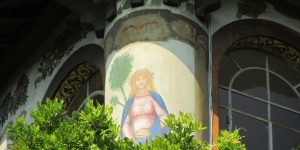
Virginio Muzio was a renowned architect from Bergamo very active during the late XIX Century especially for what concerned refurbishment and enlargement of religious buildings, both in the city and the province: the facade of Alzano Lombardo parish church, the churchyard and the porch of Clusone church, the restorations of the Archpriest House (“Casa dell'Arciprete”) and Sant'Agostino Convent, the recomposition of Santa Maria Maggiore Baptistery. Moreover, he was also one of the first architects bringing Liberty style to buildings like Casa Paleni and Ristorante Belvedere.
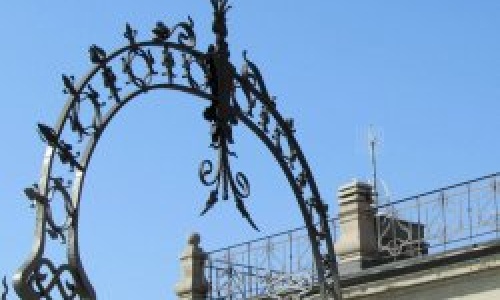
In via Sudorno, more precisely at number 22-24, you can admire the former Ristorante Belvedere (1900-1902). This peculiar building was converted into a restaurant by Virginio Muzio and is currently a private dwelling. The view of the hills and the plain is framed by the beautiful gate and it is the same one guests could admire from the two terraces.
As you get to the crossroad with via Torni, you can see Casa Maffettini in front of you, renovated in the early XX Century. In fact, the family decided to decorate all the window frames with the monogram M and L, thus creating a very refined and sinuous pattern.
Walk till number 12, where you will find Villa Neri, surrounded by vegetation, featuring a wonderful facade frescoed with beautiful female figures.
In via Sudorno, more precisely at number 22-24, you can admire the former Ristorante Belvedere (1900-1902). This peculiar building was converted into a restaurant by Virginio Muzio and is currently a private dwelling. The view of the hills and the plain is framed by the beautiful gate and it is the same one guests could admire from the two terraces.
As you get to the crossroad with via Torni, you can see Casa Maffettini in front of you, renovated in the early XX Century. In fact, the family decided to decorate all the window frames with the monogram M and L, thus creating a very refined and sinuous pattern.
Walk till number 12, where you will find Villa Neri, surrounded by vegetation, featuring a wonderful facade frescoed with beautiful female figures.
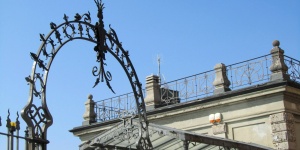
The building where Ristorante Belvedere used to be was readapted into a private house: it was designed by Virginio Muzio. The architect, who was working on several other projects over the city, had to chance to express himself by using many elegant and refined Liberty patterns, in perfect harmony with a leisure place.
According to the Ar Nouveau principle stating the need to blend architect and nature, Muzio modified a preexisting building and chose an unusual shape, which is perfectly in tune with the intended use and the surrounding environment. Two low buildings, topped by two terraces linked by the entrance courtyard overlooking the hills. The wrought iron arch welcoming the guests, light and graceful, is one of the most beautiful iron pieces in the whole city.
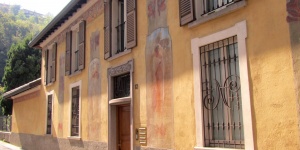
In the early XX Century, the Neri Family decided to enlarge and renovate the villa, taking this opportunity to enrich it with refined Liberty decorations.
The dwelling, featuring a lovely garden, is surrounded by the quiet city streets leading towards the hills and the Astino Valley. The facade overlooking the road was embellished by remarkable frescoes.
The refined feminine figures reminds pre-Raphaelites works of art and the billboards of that time. They were probably realized by the artist Achille Filippini Fantoni, from Bergamo. The decoration also includes frescoed floral motifs, imitating the surrounding vegetation.